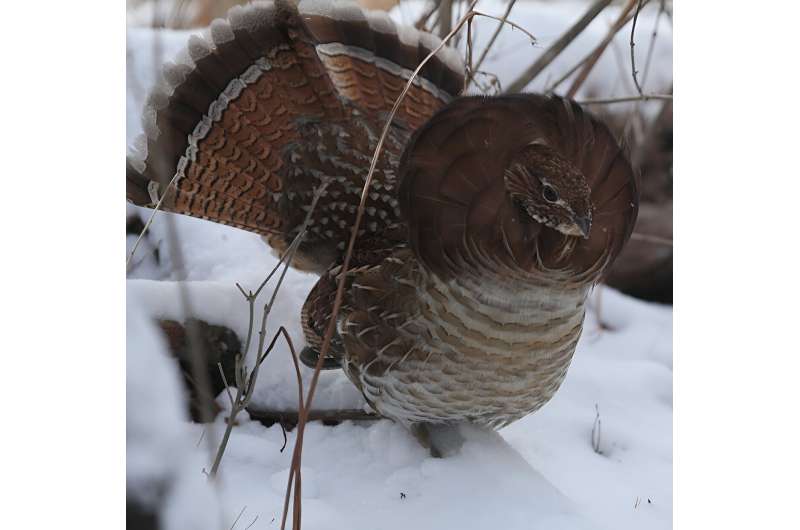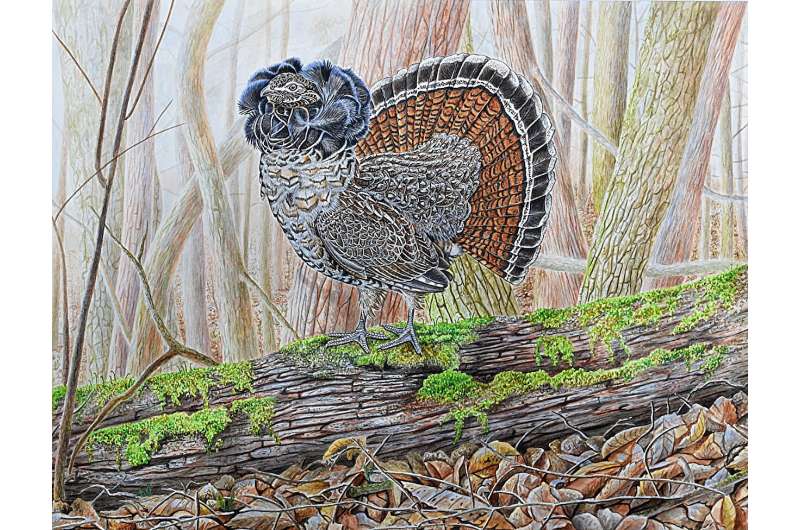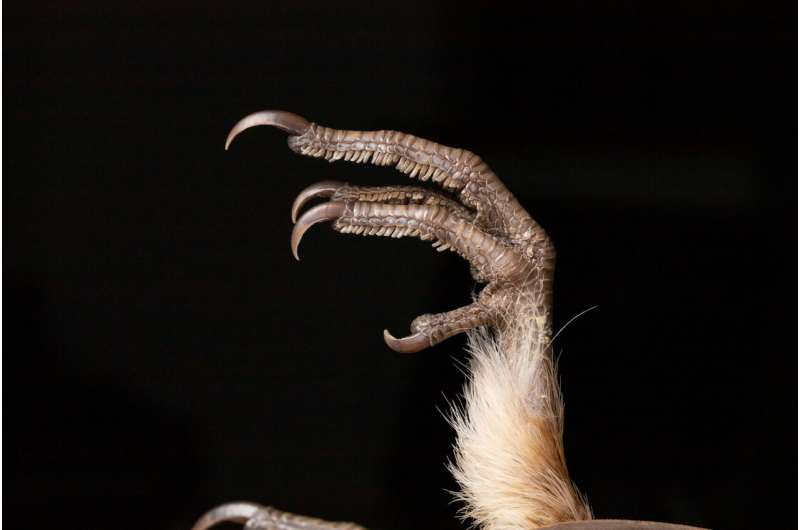This article has been reviewed according to Science X's editorial process and policies. Editors have highlighted the following attributes while ensuring the content's credibility:
fact-checked
peer-reviewed publication
trusted source
proofread
Ruffed grouse population more resilient than expected, genetic study finds

Despite decades of decline, a genetic analysis of ruffed grouse reveals that Pennsylvania's state bird harbors more genetic diversity and connectivity than expected. The findings suggest that the iconic game bird could be maintained in persistent numbers if appropriate protections are implemented. The study, led by Penn State and Pennsylvania Game Commission researchers, is published in Molecular Ecology.
According to the researchers, Pennsylvania's ruffed grouse populations have declined by up to 70% since the early 1960s, with birds in the southern part of the state particularly affected by West Nile virus, which is spread by mosquitoes, and by habitat fragmentation due to development.
"By all typical metrics, the ruffed grouse is in a state of rapid decline," said Julian Avery, associate research professor of wildlife conservation at Penn State and co-author of the paper. "Yet, until now, no one had used genetic tools to investigate the effects of this decline at a deeper level. By applying whole-genome sequencing, we have found that the bird is genetically better off than we suspected, which means that habitat protection and other management interventions can work to protect this species."
Leilton Luna, postdoctoral researcher at Penn State and corresponding author of the paper, explained that when an organism's population size drops too low because of disease or habitat loss, inbreeding can occur, which can lead to a decline in genetic diversity over time.
"Populations with low genetic diversity have a harder time evolving in response to changing environmental conditions and are at greater risk of extinction," Luna said. "In the case of the Pennsylvania ruffed grouse, due to the sharp population decline, it certainly doesn't have the same healthy genetic conditions as it did in the past. Even so, the current levels of genetic diversity and connectivity give us great hope for the preservation of this species."
As an initial step, the team produced the first high-quality reference genome for ruffed grouse. A reference genome, Luna said, is a representative example of a particular organism's genes.
"This reference genome serves as a standardized genetic baseline, facilitating accurate comparisons of genome-wide diversity between individuals and populations," Luna said. "Additionally, this genomic resource will enable us to investigate important questions, such as whether specific genetic components, like adapted genes, contribute to varying population responses to West Nile virus in different ruffed grouse populations."

To investigate the population health of the ruffed grouse in Pennsylvania, the research team sequenced 54 individual bird genomes within habitats that were both fragmented by development and intact. The researchers examined the sequence data for evidence of gene flow, which indicates that genetic material is readily exchanged among migrating populations.
"We compared each individual to every other individual that we sampled," Luna said. "By doing this, we were able to tell if the birds all belong to a single geographic population or to different populations, as well as how environmental factors such as habitat fragmentation and terrain elevation shape the effective dispersal of birds, and therefore, the exchange of genes."
He said the team's DNA analysis provided weak evidence of population subdivision across the state, although the researchers identified reduced genetic connectivity in the south, where the bird's habitat is fragmented by human development.
"This tells us that the population may not be doing as bad as we expected," Luna said. "It also helped us to inform wildlife managers which areas would most benefit from the development of habitat corridors. However, it is just a snapshot of the population at this particular moment. In the future, we hope to analyze the DNA of museum specimens so we can compare the genetic diversity and connectivity of today's populations with those from before West Nile virus was present and before the habitat was so fragmented."
Surprisingly, the team said, it also stumbled onto the presence of two genetic "anomalies," called chromosomal inversions. These occur when a segment of DNA breaks off and then reattaches in reverse order.
"We found chromosomal inversions within some of the individuals we sampled, and these were found in individuals from across the Commonwealth," said co-author David Toews, assistant professor of biology at Penn State.
"The data are very clear," he said. "There are these two large chunks of the ruffed grouse genome that are highly differentiated from the rest of the genome, and they are not associated with any obvious geographic pattern among the birds. It adds a fun ruffle to the story."

Toews noted that chromosomal inversions previously were found in other bird species and were expressed via different plumage patterns or more aggressive behaviors, for example. He said the team does not yet know how the inversions might affect the ruffed grouse. It's a topic the team plans to further investigate.
In the meantime, Toews said, the chromosomal inversions have important implications for conservation.
"On the surface, all ruffed grouse look fairly similar, but they actually have deep genetic differences," he said. "In the context of conservation, it may be important to think beyond the species overall to consider protecting individuals with these genetic variations."
Avery noted that Penn State has a long history of working with state agencies—such as the Pennsylvania Game Commission, Pennsylvania Fish and Boat Commission and Pennsylvania Department of Conservation and Natural Resources—to collect and analyze scientific data that can help inform conservation strategies. He said the team's findings suggest that certain management interventions may help the bird to maintain healthy populations. These include:
- Creating and maintaining habitats that functionally connect forested regions and populations
- Evaluating the impact of hunting to ensure harvest is not contributing to the decline of more vulnerable populations
- Implementing periodic genetic monitoring to track changes and assess whether habitat interventions lead to positive genetic changes
"Not only do ruffed grouse play an important role in the ecosystem, but they are also really interesting," Avery said. "The males make this drumming sound in the spring to attract mates. You can physically feel the bass when they're drumming in the woods. They also pair the drumming with a flashy display of ornamental feathers and a spread tail, similar to the over-the-top performance of a male peacock. To top it off, during the fall, ruffed grouse grow these fascinating extensions of their toe scales that may help to increase surface area during the winter months. They're just beautiful and bizarre, and they deserve our conservation attention."
Other authors on the paper include Lisa Williams, wildlife biologist; Kenneth Duren, game bird section supervisor; and Reina Tyl, wildlife biologist, all at the Pennsylvania Game Commission.
More information: Leilton W. Luna et al, Whole genome assessment of a declining game bird reveals cryptic genetic structure and insights for population management, Molecular Ecology (2023). DOI: 10.1111/mec.17129
Journal information: Molecular Ecology
Provided by Pennsylvania State University


















